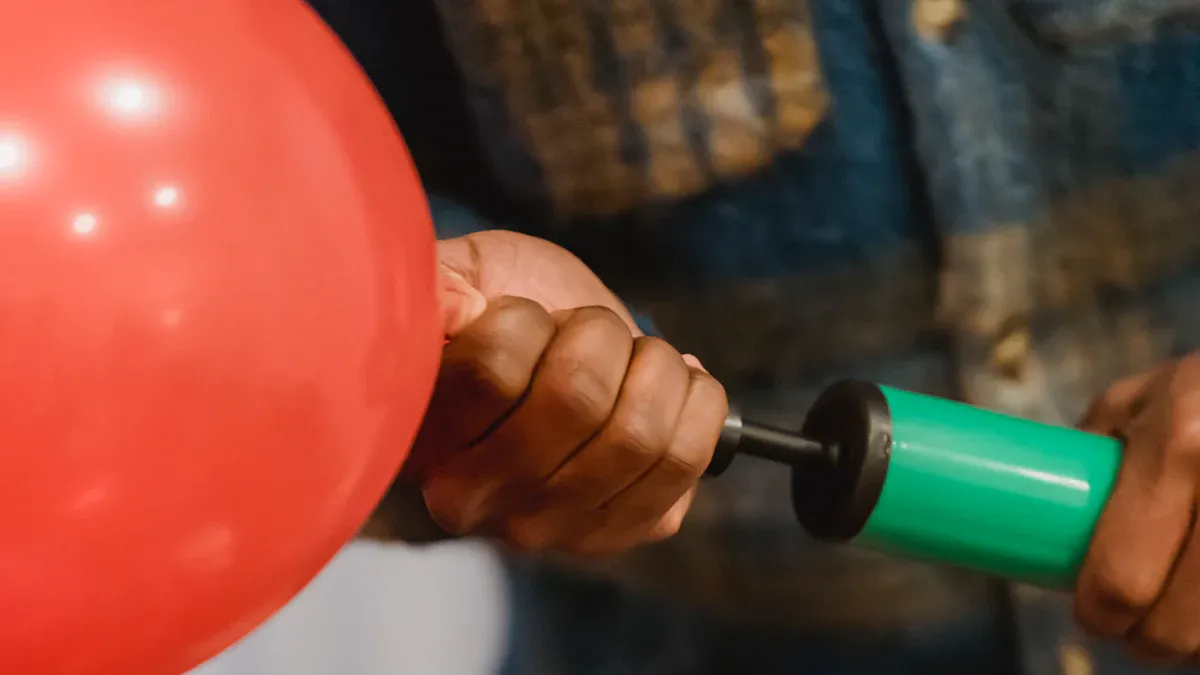Balloon pendant decoration definition
Balloon pendant decoration is also a stylish, creative and unique art. Nowadays, individual and creative ornaments are always indispensable in various activities and occasions. All kinds of unique ornaments decorate every detail in our life. It can catch people’s attention at once, create a warm scene, set off a joyful atmosphere, and decorate and beautify the environment.
Types of balloon ornaments
Pentagram pendants, heart pendants, pyramid pendants, candy pendants, bracelet pendants, gift box pendants and more. Most of them are made of PP plastic material, and some of them have cement blocks inside and are packed with aluminum foil paper, and the quality is quite good.
The difference and parameters of balloon gravity drop
The candy pendant is a cement stone pendant with a strong sense of gravity, and the weight of each is about 116g/piece (about 0.23 catties).
Pyramid pendants and gift box pendants are hollow inside, and after disassembly, small iron blocks or pebbles can be placed inside to increase the weight. A single pyramid pendant is about 25g, about .5cm wide, and about 6.2cm high. The gift box pendant is about 70g each, about 6cm wide and 6.2cm high.
A single pendant with five pointed stars weighs about 130g and is available in a variety of colors.
The individual weight of the bear pendant is about 11.4g, the width is 5.5cm, and the height is 9cm.
A single heart-shaped pendant weighs about 7g, is 6cm wide and 6.5cm high.
The round smiley face pendant weighs about 9.6g and has a diameter of 7.5cm.
Pentagram thin pendant weighs about 7g, measures 7.5cm in width and 8cm in height.
The single weight of the bracelet round pendant is about 20g, and the diameter is about 7.5cm.

Balloon Pendant Advantages and Scene Decoration
As an event decoration prop, balloons often appear in various event sites. Balloons not only have bright colors, but also have a variety of shapes to choose from, which are very popular among children and young people. With the continuous advancement of social science and technology, balloons also change accordingly, with a constant exterior and an ever-changing interior. The appearance of the balloon is still bright, but the inflation inside is varied. Followed by aluminum film balloons, air balloons and so on. Today we mainly introduce the general trend of aluminum film balloons. Aluminum film balloons are also called aluminum foil balloons and helium balloons in China. According to different occasions, they can be divided into: birthday party balloons, toy cartoon aluminum film balloons, gift balloons, wedding decoration balloons, advertising balloons, Valentine’s Day balloons, Children’s Day balloons, Various festive balloons such as Christmas balloons.
Because the aluminum film balloon is a floating balloon, you should pay attention to fixing it when you use it. Whether you are using it or playing with it, you must fix it well, so as not to let the balloon fly away. Once it is floating, it is difficult to get it back. And flying balloons will cause environmental pollution, because aluminum film balloons are not easy to degrade, or even non-degradable, so if they are released on land or in river sea water, they will not degrade, and floating balloons may It will cause high-voltage power failure, so we must pay attention to it. So how right it is to use a balloon gravity pendant to reduce the risk.
balloon pendant use
It is used at the bottom of the helium floating balloon to play the role of decoration and load bearing. By using it with the balloon rope, it can control the height of the balloon flying.
How to use the balloon pendant
There is a special ring on the top of the balloon pendant for tying the balloon rope, and the helium balloon is directly tied to it.

plastic molding process
The choice of plastic molding is mainly determined by the type of plastic (thermoplastic or thermosetting), the starting form, and the shape and size of the product. Commonly used methods for processing thermoplastics include extrusion, injection molding, calendering, blow molding, and thermoforming. Processing thermosetting plastics generally uses molding, transfer molding, and injection molding. Plastic molding is the process of making plastics in various forms (powder, pellets, solutions and dispersions) into products or blanks of the desired shape.
Factors affecting the change of shrinkage rate:
(1) Plastic Varieties Various plastics have their own shrinkage ranges, and the same type of plastics has different shrinkage rates and anisotropy due to different fillers, molecular weights, and proportions.
(2) Characteristics of plastic parts The shape, size, wall thickness, presence or absence of inserts, the number and layout of inserts of plastic parts also have a great influence on the shrinkage rate.
(3) Mold structure The parting surface and pressure direction of the mold, the form, layout and size of the pouring system also have a great influence on the shrinkage rate and directionality, especially in extrusion and injection molding.
(4) Forming process Extrusion molding and injection molding processes generally have a large shrinkage rate and obvious directionality. Preheating conditions, forming temperature, forming pressure, holding time, filler form and hardening uniformity all have an impact on shrinkage and directionality.
The ability of a plastic to fill a cavity at a certain temperature and pressure is called fluidity. This is an important process parameter that must be considered in mold design. High fluidity can easily lead to excessive flash, insufficient filling cavity, loose structure of plastic parts, separate accumulation of resin and filler, easy sticking to the mold, difficulty in demoulding and cleaning, and premature hardening. However, if the fluidity is small, the filling is insufficient, it is not easy to form, and the forming pressure is high. Therefore, the fluidity of the selected plastic must be compatible with the requirements of the plastic part, the forming process and the forming conditions.
































